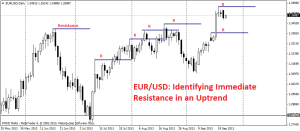Support and Resistance (S&R) is one of the first things beginners learn when studying technical analysis in Forex. It seems that every book mentions it, every website has a few articles about it, but how can we implement it in a trading plan?
I recently read an article by Chris Scvorcik, and his identification of near-term S&R struck me as genius. He calculates immediate S&R by looking at the recent daily highs and lows:
In an uptrend a pause of one day (no new daily high) is equal to a minor resistance;
In an uptrend a pause of two days (no new daily high) is equal to a major resistance;
In a downtrend a pause of one day (no new daily low) is equal to a minor support;
In a downtrend a pause of two days (no new daily low) is equal to a major support.
Source: “A Million USD Forex Strategy” by Chris Scvorcik
Step 1: Identify a near-term level of Support or Resistance
Here is an example of a EUR/USD Chart where I’ve identified various near-term levels of S&R.

Step 2: Determine if you are trading a Trend-Continuation Setup (Trend-Following Traders) or a Trend-Reversal Setup (Counter-Trend Traders)
One of the major rules of determining S&R is that the more times the S&R is touched and respected by price, the more powerful the S&R.
When determining these levels we are in effect determining a level of S&R that has only been touched once. Breakouts continuations are therefore likely to be just that – trend continuations. Chris explains in his article, (and I highly recommend that you read it), how these levels of Support and Resistance may be used either as a Trend-Continuation Setup or combined with other indicators as a Trend-Reversal Setup.
Step 3: Trend Setup – Determine if you are using this signal as a Filter, Entry Trigger or Confirmation
This decision must, in fact, be made with every indicator, tool, oscillator that you use.
1. Entry Filter – If you want to use the S&R level as a filter, consider a rule that would not allow you to respect your entry trigger until a new high has been made.
2. Entry Trigger – These short-term S&R levels have the potential to be great entry triggers into a trend. Other filters must be used to determine the direction of a trend, then once you determine one of these levels all you have to do is wait for the continuation breakout. Wait for the daily candle to close to be sure a breakout has occurred. Place a limit order above (below in a downtrend) the breakout to be filled on a price continuation.
3. Confirmation – An interesting alternative to a filter. Maybe your entry criteria is triggered, all your filters say go so you take the trade. However, you can use this as a confirmation, for example if you are unable to pass the S&R in 2 or 3 days you close the position.
